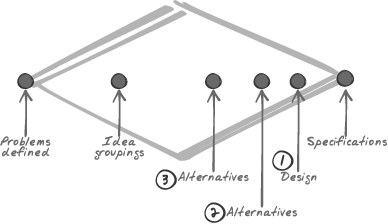6.3. Checkpoints for design phases
The best way to manage ideas is to start any major design work with clear checkpoints for how the time should be used. Instead of having only two checkpoints, requirements (or problem definition), and spec writing, some intermediary points need to be defined before creative work is going at full speed. It's the project manager's job to make sure these points in time are created (and that everyone understands their usefulness), although it might be best if the designers or engineers define the specifics for when those points in time occur and what the criteria should be for reaching them.(2) There are many different ways to do this, and the best way will vary from project to project and team to team. But, as a basic rule of thumb, here are the key points in time (illustrated in Figure 6-3).
Figure 6-3. Checkpoints for design.

Vision and proof-of-concept. If the vision document is delivered with a proof of concept prototype, the design and creative effort has a head start. There will already be design ideas and engineering concepts to investigate and build off of (or reject, but with improved understanding of the problem). It's not a good vision if it doesn't have at least a rough proof- of-concept design prototype.
Idea groupings/lists. After the initial wave of new ideas and possible approaches are raised, someone has to organize and consolidate ...
Get The Art of Project Management now with the O’Reilly learning platform.
O’Reilly members experience books, live events, courses curated by job role, and more from O’Reilly and nearly 200 top publishers.

